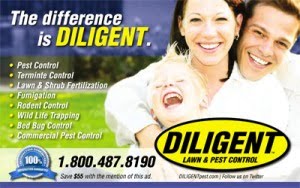Not all Termite Companies are the same, that’s why more people choose DILIGENT for total termite protection! When DILIGENT treats your home for Termites we provide you with the only warranty in the industry that provides Full Coverage and Total Protection against all types of termite infestations and termite damage. Choosing DILIGENT means that you do not have to wonder if your home is protected against a particular termite infestation because we provide total protection with our Repair & Retreatment Warranty. DILIGENT’s termite warranty coverage includes protection for the subterranean termite, Formosan Termite and the flying Drywood Termite just to name a few. We get rid of your termite infestation with the right termite solution at a fair price so termite swarms become a thing of the past. DILIGENT Termite Control will get rid of these infestations with environmentally friendly termite treatments that will protect you against these very destructive pests.




